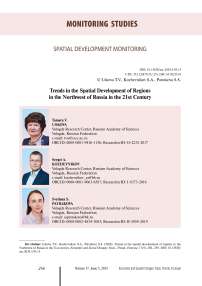Trends in the spatial development of regions in the northwest of Russia in the 21st century
Автор: Uskova T.V., Kozhevnikov S.A., Patrakova S.S.
Журнал: Economic and Social Changes: Facts, Trends, Forecast @volnc-esc-en
Рубрика: Spatial development monitoring
Статья в выпуске: 5 т.17, 2024 года.
Бесплатный доступ
Russia, being the largest country in the world in terms of territory, attaches great importance to the effective use of its vast space. The paper considers findings of a monitoring of the current situation and key trends regarding spatial development of the Northwestern Federal District and the RF constituent entities included in it. Spatial development of the macro region is studied from the position of centerperipheral and frame approaches; spatial organization is considered taking into account the transformation of the settlement, production, economic and infrastructural frames. The conclusion is made about the increasing nature of the centripetal vector of development and peripherization at the macro and intraregional levels (this is especially acute in the regions of the North). In addition, the paper presents current estimates (2020-2023) of the ranks of Northwestern regions among RF constituent entities on key indicators of spatial development, which can be used by federal and regional authorities as part of monitoring and revising their policies. We prove that an important task is to create conditions conducive to the development of the spatial frame of the macro region by unlocking the potential of various kinds of localities (cities and agglomerations of various levels of hierarchy, rural, industrial periphery). We substantiate a set of measures to increase the connectivity of the macro region’s space, which are in line with the priorities of the new Concept and draft Strategy for Spatial Development of the Russian Federation until 2036.
Spatial frame, agglomeration processes, locational compression, strategic priorities, connectivity of space, northwest of Russia
Короткий адрес: https://sciup.org/147245882
IDR: 147245882 | УДК: 332.12(470.23/.25) | DOI: 10.15838/esc.2024.5.95.15
Список литературы Trends in the spatial development of regions in the northwest of Russia in the 21st century
- Baranskii N.N. (1956). On the economic and geographical study of cities. In: Ekonomicheskaya geografiya. Ekonomicheskaya kartografiya [Economic Geography. Economic Cartography]. Moscow: Geografgiz.
- Castells М. (2000). Informatsionnaya epokha: ekonomika, obshchestvo i kul’tura [The Information Age Economy, Society and Culture]. Moscow: GU-VSH.
- Dem’yanenko A.N., Isaev A.G. (2015). On cyclical processes in the economic space of Russia. Regionalistika, 2(5-6), 6–17. DOI: 10.14530/reg.2015.5-6
- Dmitrieva T.E. (2016). The effective space – factor in the development of the Komi Republic. Izvestiya Komi nauchnogo tsentra UrO RAN, 3(27), 111–120 (in Russian).
- Dmitrieva T.E. (2023). Settlement patterns as a foundation of an efficient space for regional social development in the North: A case study of the Komi Republic. Sever i rynok: formirovanie ekonomicheskogo poryadka=The North and the Market. Forming The Economic Order, 4, 34–48 (in Russian).
- Friedmann J. (1966). Regional Development Policy: A Case Study of Venezuela. MIT Press.
- Gainanov D.A., Gataullin R.F., Ataeva A.G. (2021). Methodological approach and tools for ensuring region’s balanced spatial development. Ekonomicheskie i sotsial’nye peremeny: fakty, tendentsii, prognoz=Economic and Social Changes: Facts, Trends, Forecast, 14(2), 75–91. DOI: 10.15838/esc.2021.2.74.5 (in Russian).
- Ilyin V.A., Morev M.V. (2022). The rubicon has been crossed: February 24, 2022, Russia entered a new stage in its development in the 21st century. Ekonomicheskie i sotsial’nye peremeny: fakty, tendentsii, prognoz=Economic and Social Changes: Facts, Trends, Forecast, 15(2), 9–30. DOI: 10.15838/esc.2022.2.80.1 (in Russian)
- Khorev B.S. (1975). Problemy gorodov (urbanizatsiya i edinaya sistema rasseleniya v SSSR) [Urban Problems (Urbanization and Unified Settlement System in the USSR)]. Moscow: Mysl’.
- Kozhevnikov S.A. (2020). Problems of project management in the public sector in the perspective of achieving national goals. Problemy razvitiya territorii=Problems of Territory’s Development, 1(105), 64–77. DOI: 10.15838/ptd.2020.1.105.5 (in Russian).
- Kryukov V.A., Lavrovskii B.L., Seliverstov V.E., Suslov V.I., Suslov N.I. (2020). Siberian development vector: Cooperation and interaction at the heart of it. Problemy prognozirovaniya=Studies on Russian Economic Development, 5(182), 46–59. DOI: 10.1134/S1075700720050111 (in Russian).
- Kurushina E.V. (2019). Upravlenie prostranstvennym razvitiem na osnove mezhregional’noi ekonomicheskoi integratsii: monografiya [Management of Spatial Development on the Basis of Interregional Economic Integration: Monograph]. Tyumen: TIU.
- Kuznetsova T.V., Nikiforov L.V. (2013). On strategy of using space potential in Russia. Voprosy gosudarstvennogo i munitsipal’nogo upravleniya=Public Administration Issues, 2, 51–64 (in Russian).
- Lappo G.M. (1983). The concept of the supporting framework of the territorial structure of the national economy: Development, theoretical and practical significance. Izvestiya AN SSSR. Seriya geograficheskaya, 5, 16–28 (in Russian).
- Lazhentsev V.N. (2011). North of Russia: Distribution of productive forces and spatial development. Ekonomicheskie i sotsial’nye peremeny: fakty, tendentsii, prognoz=Economic and Social Changes: Facts, Trends, Forecast, 1, 37–46 (in Russian).
- Lazhentsev V.N. (2018). Ekonomiko-geograficheskie aspekty razvitiya Severa Rossii [Economic and Geographical Aspects of the Development of the North of Russia]. Syktyvkar: ISEiEPS FITs Komi NTs UrO RAN.
- Lazhentsev V.N. (2020). The North and integration of socio-economic space (the example of North-West Russia). Problemy prognozirovaniya=Studies on Russian Economic Development, 3, 50 (in Russian).
- Luchnikov A.S., Nikolaev R.S. (2017). Economic framework optimization as an instrument for regional development. R-Economy 3(4), 213–230.
- Nefyodova T.G., Treyvish A.I. (2020). Polarization and shrinkage of active space in the core of Russia: Trends, problems and possible solutions. Demograficheskoe obozrenie=Demographic Review, 7(2), 31–53 (in Russian).
- Yakovleva S.I. (2013). Wireframe in regional scheme of territorial planning. Pskovskii regionologicheskii zhurnal, 15, 15–25 (in Russian).


